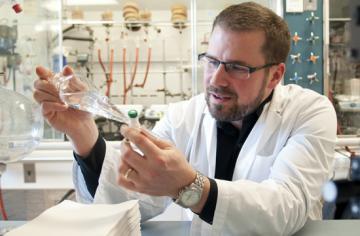New research chairs tackle molecular basis of disease
- Valerie Shore

Collaborative work by the University of Victoria’s two newest Canada Research Chairs may one day slow down the spread of influenza—especially when the next global pandemic strikes. Organic chemist Jeremy Wulff and biochemist Martin Boulanger are among a slate of new and renewed Canada Research Chairs across the country that were announced on March 13 by Gary Goodyear, Minister of State for Science and Technology.
As the Canada Research Chair in Bioactive Small Molecule Synthesis, Wulff builds complex molecular structures and assesses their potential for new drugs in the treatment of diseases such as cancer, influenza and HIV/AIDS.
As the Canada Research Chair in Molecular Interactions and Structural Biology, Boulanger studies structural interactions between proteins, especially in parasitic diseases such as malaria and toxoplasmosis.
A common area of focus for the two scientists is the flu virus. Every year, the virus infects about 10 per cent of the world’s human population and causes hundreds of thousands of deaths. In North America alone, nearly 40,000 people die from the flu or a secondary bacterial infection annually.
Flu is currently treated with three antiviral drugs— Tamiflu, Relenza and Peramivir—but each has drawbacks, including the emergence of resistant viral strains.
“Sooner or later, we’re likely to be hit with a pandemic strain of influenza that is highly transmissible and lethal, and doesn’t respond to existing therapeutics,” says Wulff. “There’s a pressing need for the creation of next-generation antiviral agents.”
Wulff and Boulanger have engineered a new type of antiviral agent that includes the best features of all three existing drugs in a single molecule. “We go further by making ours more rigid so that it has more ‘specificity’— it binds only with the flu virus target,” says Wulff.
To date, the team has built the molecule’s “scaffold,” or frame. The next step is to add the molecular parts that will interact with—and inhibit—enzymes on the target virus. To do that, the team will use a technique known as x-ray crystallography to generate a high-resolution, three-dimensional picture of the target site.
“With this information we will be poised to design highly selective drug-like molecules in the same way that a key (the drug) fits a specific lock (the drug target),” says Boulanger.
Now in its 12th year, the Canada Research Chairs program helps Canadian universities strengthen their position as global leaders in research and development, bringing greater economic opportunities for Canadians.
The March announcement included the renewal of UVic geographer Aleck Ostry as the Canada Research Chair in the Social Determinants of Community Health. UVic now has 38 filled Canada Research Chairs.


